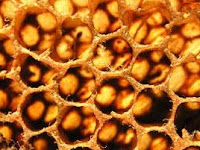 Honeybees produce honey from nectar, which is a sweet substance that “special glands in flowers produce” (Morse, 2009). Flowers produce this liquid to attract pollinators (the honeybee is one of them). Nectar has a high water content (50-90%), while sugar (basically sucrose) constitutes 10-50% of it. Honeybees reduce the water content of nectar to 10-14% and split sucrose molecules into two smaller sugar molecules (levulose and dextrose). Honeybees also add glucose oxidase to the mixture, which is an enzyme that breaks down dextrose (in diluted honey) into gluconic acid and hydrogen peroxide which hinders bacterial growth in honey. After all these modifications of nectar, we obtain honey.
Honeybees produce honey from nectar, which is a sweet substance that “special glands in flowers produce” (Morse, 2009). Flowers produce this liquid to attract pollinators (the honeybee is one of them). Nectar has a high water content (50-90%), while sugar (basically sucrose) constitutes 10-50% of it. Honeybees reduce the water content of nectar to 10-14% and split sucrose molecules into two smaller sugar molecules (levulose and dextrose). Honeybees also add glucose oxidase to the mixture, which is an enzyme that breaks down dextrose (in diluted honey) into gluconic acid and hydrogen peroxide which hinders bacterial growth in honey. After all these modifications of nectar, we obtain honey.Wilson, T. V. How Bees Work. (n.d.) HowStuffworks, retrieved Friday July 10th 2009 from http://www.howstuffworks.com/
Image:
[Each cell can hold honey or a single developing bee].(n.d.) Howstuffworks. Retrieved Saturday July 11th 2009 from www.howstuffworks.com
No comments:
Post a Comment